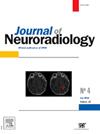Muesli sign for the detection of non-ishemic cerebral enhancing (NICE) lesions afte endovascular treatment.
IF 3
3区 医学
Q2 CLINICAL NEUROLOGY
引用次数: 0
Abstract
Introduction
Cerebral granulomatous foreign body reactions, also called delayed onset non-ischemic cerebral enhancing lesions (abbr. (NICE)) are a rare complication following endovascular procedures like aneurysm embolization (Cruz Krings AJNR 2014, Shotar Neuroimaging 2021) or mechanical thrombectomy for acute ischemic stroke (Forestier 2022, Mehta, Abbasi).
The NICE lesions described in the literature are characterized by nodular enhancement on contrast enhanced follow-up MRI scans (Shapiro 2015, Shotar Neuroradiology 2016) surrounded by vasogenic oedema. In several patients those lesions detected on MRI imaging were histologically correlated to the presence of non-caseating intracerebral foreign-body granulomas and were attributed to transarterial embolization of microscopically fragmented material during a culprit endovascular procedure (Shapiro 2015) resulting in persistent or recurrent focal inflammation. However, new MRI signs could further facilitate diagnosis and make MRI combined with the patient's history more specific regarding the diagnosic of NICE lesions. In this case series we describe the ?Muesli sign? and hypothesize that it is an imaging feature aiding in the detection of cerebral foreign body reactions (NICE lesions) in non-contrast-enhanced MRI follow up imaging of patients after endovascular procedures.
Methods
A retrospective review of all patients with endovascular neuroangiographic treatments for intracranial arterial aneurysms, AVM, acute ischemic stroke performed between from January 1, 2012 to June 30, 2023, and reported to our registry of NICE lesions was undertaken. The presence of hypointense nodules randomly distributed in a homogenously hyperintense region resembles the appearance of cereals in milk, in German language called Muesli, hence the name for the appearance on MRI T2 imaging.
Results
Overall, 57 patients were included in the analyses: 54 patients received endovascular treatment for intracranial aneurysms (93.0%), 3 patients (5.3%) were treated with mechanical thrombectomy for acute ischemic stroke, 1 patient was treated for a cerebral AVM using a EVOH liquid embolic agent (1.7%). Overall, in any kind of T2 weighted imaging (spinecho or FLAIR), the Muesli sign was identified in 42 of 57 patients by both independent reviewers (73.7% prevalence of the Muesli sign in T2 weighted imaging of NICE lesion patients) and was unanimously found absent in 16 of 57 patients (28.1% of confirmed NICE lesion patients had a negative Muesli sign). Overall, there was disagreement concerning the presence of the Muesli sign in 3 of 57 patients (5.3%).
Conclusion
Based on our observations the 'Muesli sign', which is for the first time described in this study, allows the detection of NICE lesions in non-contrast brain MRI scans, and was present in 3 of 4 patients when T2 weighted imaging was available with excellent interrater agreement for the Muesli sign detection.
Muesli征象用于血管内治疗后非缺血性脑增强(NICE)病变的检测。
脑肉芽肿性异物反应,也称为迟发性非缺血性脑增强病变(简称NICE),是动脉瘤栓塞(Cruz Krings AJNR 2014, Shotar Neuroimaging 2021)或急性缺血性卒中机械取栓等血管内手术后的罕见并发症(Forestier 2022, Mehta, Abbasi)。文献中描述的NICE病变在后续MRI增强扫描中表现为结节性强化(Shapiro 2015, Shotar Neuroradiology 2016),周围为血管源性水肿。在一些患者中,MRI成像检测到的病变在组织学上与非干酪化性脑内异物肉芽肿的存在相关,并归因于罪魁祸首血管内手术过程中经动脉栓塞的显微碎片物质(Shapiro 2015),导致持续或复发性局灶性炎症。然而,新的MRI征象可以进一步促进诊断,并使MRI结合患者病史对NICE病变的诊断更具特异性。在这个系列中,我们描述了穆斯利符号?并假设在血管内手术后患者的非增强MRI随访成像中,它是一种有助于检测脑异物反应(NICE病变)的成像特征。方法回顾性分析2012年1月1日至2023年6月30日期间所有经血管内神经血管造影治疗颅内动脉瘤、AVM、急性缺血性脑卒中的患者,并在我们的NICE病变登记处进行报告。低强度结节随机分布在均匀的高强度区域,类似于牛奶中的谷物,德语称为Muesli,因此在MRI T2成像上的外观。结果共纳入57例患者:颅内动脉瘤行血管内治疗54例(93.0%),急性缺血性脑卒中机械取栓3例(5.3%),脑AVM行EVOH液体栓塞剂治疗1例(1.7%)。总的来说,在任何类型的T2加权成像(spinecho或FLAIR)中,57例患者中有42例发现了Muesli征象(NICE病变患者T2加权成像中Muesli征象的发生率为73.7%),57例患者中有16例未发现Muesli征象(28.1%的确诊NICE病变患者有阴性Muesli征象)。总的来说,57例患者中有3例(5.3%)对是否存在Muesli征存在分歧。根据我们的观察,在本研究中首次描述的“Muesli征象”允许在非对比脑MRI扫描中检测NICE病变,并且当T2加权成像可用时,4例患者中有3例存在Muesli征象检测,具有出色的判读一致性。
本文章由计算机程序翻译,如有差异,请以英文原文为准。
求助全文
约1分钟内获得全文
求助全文
来源期刊

Journal of Neuroradiology
医学-核医学
CiteScore
6.10
自引率
5.70%
发文量
142
审稿时长
6-12 weeks
期刊介绍:
The Journal of Neuroradiology is a peer-reviewed journal, publishing worldwide clinical and basic research in the field of diagnostic and Interventional neuroradiology, translational and molecular neuroimaging, and artificial intelligence in neuroradiology.
The Journal of Neuroradiology considers for publication articles, reviews, technical notes and letters to the editors (correspondence section), provided that the methodology and scientific content are of high quality, and that the results will have substantial clinical impact and/or physiological importance.
 求助内容:
求助内容: 应助结果提醒方式:
应助结果提醒方式:


